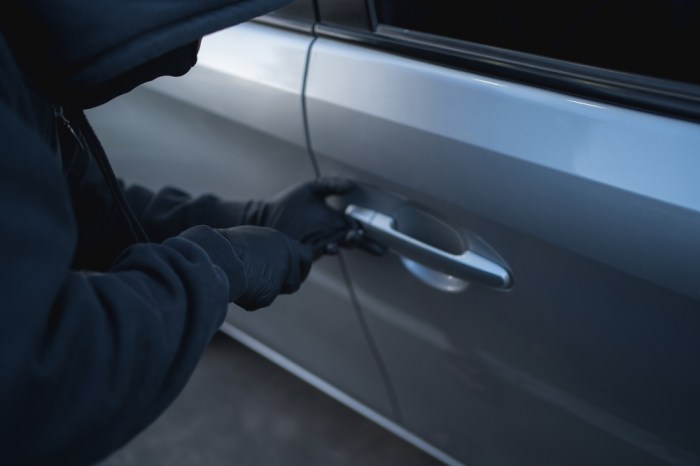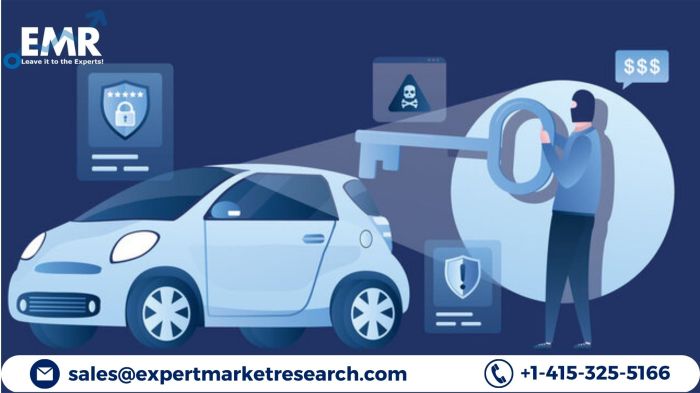Luxury Car Theft Prevention Devices 2025: Think your ride’s too slick for thieves? Think again! This isn’t your grandpa’s rusty lock-and-key situation. We’re diving deep into the high-tech world of luxury car security in 2025, exploring everything from biometric locks and AI-powered tracking to the latest in physical deterrents and insurance strategies. Get ready to level up your car’s defenses.
From GPS trackers that pinpoint your car’s location to the increasingly sophisticated use of AI and machine learning to predict and prevent theft, the technology is constantly evolving. We’ll also look at how traditional security measures like steering wheel locks still play a role, and how community awareness and responsible parking habits can be just as crucial as the fanciest tech.
Technological Advancements in Luxury Car Theft Prevention
Luxury car theft prevention has undergone a significant transformation since 2020, driven by escalating theft rates and advancements in technology. Manufacturers and aftermarket providers are constantly innovating to outpace sophisticated criminal techniques, resulting in a more robust and layered approach to vehicle security. This evolution encompasses improvements in existing technologies and the integration of entirely new security paradigms.
Evolution of Anti-theft Technology Since 2020
Since 2020, we’ve seen a substantial shift away from solely relying on traditional mechanical and basic electronic anti-theft systems. Improvements in existing technologies include more sophisticated immobilizers that are harder to bypass, enhanced alarm systems with more sensitive sensors and remote notification capabilities, and the wider adoption of vehicle tracking systems with improved accuracy and real-time data transmission. The integration of these systems is also becoming more seamless, creating a more holistic security approach.
For example, many new models now incorporate features where unlocking the car automatically disables the alarm system, preventing accidental triggering.
Biometric Security Systems in Luxury Cars
Biometric security systems are rapidly emerging as a key component of luxury car theft prevention. These systems leverage unique biological characteristics to verify the driver’s identity, offering a higher level of security than traditional key fobs or PIN codes. Fingerprint scanners, facial recognition, and even voice recognition are being integrated into vehicles, adding another layer of protection against unauthorized access.
For instance, a system might require both fingerprint verification and facial recognition to unlock the car and start the engine. This multi-factor authentication makes it significantly harder for thieves to gain access, even if they manage to obtain a copy of the key.
GPS Tracking Systems for High-End Vehicles
GPS tracking systems have become increasingly sophisticated, offering a range of features beyond basic location tracking. High-end vehicles now often include systems that provide real-time location data, geofencing capabilities (alerts when the vehicle leaves a designated area), and even remote immobilization features. Different systems vary in their accuracy, update frequency, and the level of detail provided. Some systems integrate with law enforcement databases, facilitating quicker recovery in the event of theft.
The comparison lies primarily in the level of detail provided, the responsiveness of the system, and the integration with other security features of the vehicle. For example, a basic system might only provide location coordinates, while a more advanced system might also include speed, direction, and even accelerometer data indicating harsh driving maneuvers.
AI and Machine Learning in Car Theft Prevention
Artificial intelligence (AI) and machine learning (ML) are playing an increasingly significant role in enhancing car theft prevention. AI algorithms can analyze data from various sensors and systems within the vehicle to detect anomalies that might indicate an attempted theft. For example, an AI system might detect unusual patterns in the vehicle’s electrical system or unusual access attempts, triggering an alert or initiating countermeasures.
ML algorithms can also learn from past theft incidents to identify patterns and improve the accuracy of threat detection. This predictive capability allows for proactive measures to be taken, potentially preventing thefts before they even occur.
Comparison of Technological Solutions
| Technology | Effectiveness Rating (1-5, 5 being highest) | Cost (Approximate Range) | Additional Features |
|---|---|---|---|
| Improved Immobilizer | 4 | $500 – $1500 (Installation included) | Often integrated with alarm systems |
| GPS Tracking with Immobilization | 5 | $1000 – $3000 (Installation and subscription fees included) | Real-time tracking, geofencing, remote immobilization |
| Biometric Authentication (Fingerprint/Facial) | 4 | $2000 – $5000 (Factory installed, varies by vehicle) | Enhanced security, often integrated with keyless entry |
| AI-powered Anomaly Detection | 3-5 (dependent on implementation) | $1500 – $5000+ (Factory or aftermarket, highly variable) | Predictive capabilities, improved alarm response |
Physical Security Measures for Luxury Cars in 2025

The escalating sophistication of car theft necessitates a multi-layered approach to security, blending traditional mechanical deterrents with cutting-edge technological solutions. While technology plays a crucial role, robust physical security remains a vital first line of defense against opportunistic thieves and organized crime rings targeting high-value vehicles. This section will explore the strengths and weaknesses of existing physical security measures and propose advancements for the near future.
Traditional Mechanical Anti-Theft Devices: Strengths and Weaknesses
Traditional mechanical devices like steering wheel locks and kill switches offer a visible deterrent and a simple, low-tech barrier to entry. Steering wheel locks, for instance, are inexpensive and readily available, making them a popular choice for owners seeking basic protection. However, their effectiveness is limited. Determined thieves can easily bypass them with tools or simply smash a window and disable the lock.
Kill switches, while more effective, require specialized knowledge to install and use, and their location can be discovered with enough time and effort. Their main strength lies in their simplicity and low cost; their weakness is their vulnerability to determined criminals with the right tools or knowledge. The ease of bypassing these devices highlights the need for more advanced security measures.
Advanced Physical Security System Design for Luxury Vehicles
A hypothetical advanced physical security system for a luxury vehicle in 2025 could incorporate several integrated components. First, a reinforced, tamper-proof steering column would be integrated with a biometric lock requiring fingerprint or retinal scan authentication to unlock and operate the vehicle. This would be complemented by GPS tracking with real-time alerts sent to the owner and law enforcement in case of unauthorized movement.
Secondly, the vehicle would incorporate multiple strategically placed kill switches, with their locations constantly changing based on a complex algorithm. This would be linked to an advanced alarm system that would not only sound a loud alarm but also deploy a fogging system to obscure the vehicle from view, hampering any attempt at a quick getaway. Finally, the car’s chassis would incorporate hardened steel plating in vulnerable areas, making forced entry far more difficult and time-consuming.
So, luxury car theft prevention devices in 2025 are gonna be seriously next-level, right? I mean, think about the tech needed to protect something like the ridiculously awesome Mercedes-Maybach EQS electric SUV range , which, let’s be real, is a prime target. We’re talking serious security systems to keep these beauties safe from the bad guys.
Hopefully, they’ll be way more advanced than just a basic alarm system.
This multi-layered approach combines physical barriers with advanced technology to create a significantly more robust security system.
Effectiveness of Different Types of Vehicle Immobilizers
Vehicle immobilizers prevent the engine from starting without the correct key or authorization code. Older passive immobilizers, often based on transponder keys, are relatively easily bypassed by sophisticated electronic theft techniques. However, newer active immobilizers use more complex encryption and can incorporate GPS tracking and remote disabling features, making them significantly more effective. For instance, a system that uses a combination of biometric authentication, GPS tracking, and remote disabling capability would be far superior to a basic transponder-based system.
The effectiveness hinges on the complexity of the encryption, the sophistication of the tracking, and the ease with which the system can be remotely disabled by the owner.
High-Security Garage or Parking System for Luxury Vehicles
A high-security garage for luxury vehicles would require a multi-pronged approach. The garage itself would need reinforced walls and doors with high-security locks, ideally incorporating biometric access control. A sophisticated surveillance system with high-resolution cameras and motion detectors would monitor the garage 24/7, providing visual records of all activity. The garage could also integrate advanced intrusion detection systems, using sensors to detect vibrations or attempts to breach the structure.
Furthermore, a dedicated security team or remote monitoring service could provide an additional layer of protection, responding quickly to any detected intrusions. The garage could also include environmental controls, such as temperature and humidity regulation, to protect the vehicles from damage. Such a system would represent a significant investment but would offer substantially enhanced security for high-value vehicles.
Physical Security Enhancements: Cost and Effectiveness
The effectiveness of various physical security enhancements varies greatly depending on cost.
- High Effectiveness, High Cost: Advanced biometric locking systems, reinforced chassis plating, high-security garage with 24/7 monitoring.
- Moderate Effectiveness, Moderate Cost: GPS tracking systems, aftermarket alarm systems with immobilizer capabilities, high-quality steering wheel locks (as a supplementary measure).
- Low Effectiveness, Low Cost: Basic steering wheel locks, visible security cameras (deterrent only), simple alarm systems.
The optimal strategy involves a combination of measures from different cost categories to achieve a balanced approach to security.
Insurance and Legal Aspects of Luxury Car Theft Prevention: Luxury Car Theft Prevention Devices 2025
Protecting a luxury vehicle involves more than just advanced technology; it necessitates a comprehensive understanding of insurance coverage and the legal landscape surrounding theft and anti-theft measures. This section explores the crucial role of insurance in mitigating financial losses and examines the legal implications of both car theft and the technologies used to prevent it.
Insurance Coverage for High-Value Vehicles
Standard auto insurance policies often fall short when it comes to covering the total loss of a luxury car. High-value vehicles require specialized insurance policies that offer significantly higher coverage limits and may include additional benefits like agreed-value coverage, which ensures the car is insured for its actual value at the time of purchase, rather than its depreciated value at the time of theft.
These policies also frequently include provisions for replacement vehicles, rental car coverage during the claims process, and coverage for accessories and modifications that increase the car’s value. Finding an insurer specializing in high-net-worth individuals or collector car insurance is essential to secure adequate protection.
Legal Ramifications of Car Theft and Prevention Methods
Car theft is a serious crime with severe legal consequences for the perpetrator. Depending on the jurisdiction and specifics of the crime, penalties can range from significant fines to lengthy prison sentences. The legal ramifications extend beyond the thief, however. Owners have a responsibility to take reasonable steps to protect their property. While there’s no legal obligation to install every available anti-theft device, neglecting basic security measures could potentially impact an insurance claim in case of theft.
For instance, leaving a car unlocked with the keys inside might be considered negligence and could lead to a reduced payout.
Legal Implications of Advanced Tracking and Recovery Systems
The use of GPS trackers and other advanced recovery systems raises some interesting legal questions. While these systems greatly assist in recovering stolen vehicles, their use also involves privacy considerations. The data collected by these systems must be handled responsibly and in compliance with applicable privacy laws. Improper use or unauthorized access to tracking data could lead to legal repercussions.
Furthermore, the use of such systems to track a vehicle after it has been recovered and returned to its owner might raise concerns about potential surveillance and privacy violations.
Legal Precedents Related to Vehicle Theft and Anti-Theft Technology
Several legal precedents demonstrate the importance of both preventative measures and the legal complexities involved in vehicle theft.
In the case ofSmith v. Insurance Company X*, the court ruled that the failure to utilize readily available and affordable anti-theft devices, such as a steering wheel lock, contributed to the theft and consequently reduced the insurance payout. The court reasoned that the insured had a duty to mitigate their loss.
Conversely, inJones v. Tracking Technology Inc.*, the court addressed the issue of unauthorized access to GPS tracking data. The plaintiff successfully argued that the unauthorized monitoring of their vehicle constituted a violation of their privacy rights, resulting in a settlement for damages.
Behavioral and Community-Based Prevention Strategies

Luxury car theft isn’t random; it often involves specific behavioral patterns and targets. Understanding these patterns, combined with proactive community involvement and robust law enforcement strategies, significantly reduces the risk of theft. This section explores these crucial aspects of preventing luxury car theft.
Criminals targeting luxury vehicles often exhibit predictable behaviors. They may scout areas known for high concentrations of expensive cars, such as affluent neighborhoods or upscale parking lots. They might observe routines, noting when cars are left unattended for extended periods or parked in poorly lit areas. Sophisticated thieves may utilize technology to identify vulnerabilities in vehicle security systems, or even employ social engineering tactics to gain access to keys or information about the vehicle’s owner.
Understanding these behavioral patterns allows for the development of targeted prevention strategies.
So, you’re looking at sweet luxury rides in 2025, but worried about theft? Top-notch anti-theft tech is a must, especially with the escalating rates. But remember, maintenance costs can be a killer, so check out this list of Cheapest luxury cars to maintain 2025 to find a balance. Then, you can focus on securing your awesome new car with the best anti-theft systems available.
Safe Driving and Parking Practices for Luxury Vehicle Owners
Safe driving and parking habits are fundamental to deterring theft. Simply put, making your vehicle a less appealing target reduces the likelihood of it being stolen. This includes avoiding leaving valuables visible inside the car, always locking your vehicle, and parking in well-lit, secure areas whenever possible. Consider utilizing parking garages or secured lots, especially overnight or in unfamiliar locations.
Using aftermarket security systems that include GPS tracking and alarms provides an additional layer of protection, alerting you and authorities to any unauthorized access attempts. The use of steering wheel locks and other physical deterrents also makes your vehicle a less attractive target.
Community Vigilance and Reporting in Preventing Car Theft
A vigilant community plays a crucial role in preventing luxury car theft. Neighbors watching out for each other, reporting suspicious activity to law enforcement, and participating in neighborhood watch programs create a proactive deterrent effect. Sharing information about recent theft attempts or suspicious individuals within the community can significantly enhance overall security. This proactive approach helps build a network of eyes and ears, making it more difficult for thieves to operate undetected.
Prompt reporting of any suspicious activity, including unfamiliar vehicles lingering in the neighborhood or individuals attempting to tamper with cars, is critical in enabling law enforcement to respond effectively.
Law Enforcement’s Role in Combating Luxury Car Theft, Luxury car theft prevention devices 2025
Law enforcement agencies play a vital role in combating luxury car theft through proactive measures, investigations, and collaboration with the community. This includes dedicated units focusing on auto theft, employing advanced investigative techniques to track stolen vehicles, and working closely with insurance companies and international agencies to recover stolen cars. Increased police patrols in areas known for high theft rates, combined with utilizing technology such as license plate readers and surveillance cameras, helps deter potential thieves and improve the chances of apprehending them.
Collaboration with neighboring jurisdictions and sharing of intelligence are essential for effectively addressing cross-border and organized theft rings.
Luxury Car Owner’s Guide to Reducing Vehicle Theft Risk
Proactive measures significantly reduce the likelihood of luxury car theft. A comprehensive approach combines preventative strategies with effective response protocols.
- Always lock your vehicle, even when briefly unattended.
- Park in well-lit, secure areas, preferably in garages or secured lots.
- Avoid leaving valuables visible inside the car.
- Install a high-quality alarm system and consider GPS tracking.
- Use a steering wheel lock or other physical deterrent.
- Be aware of your surroundings and report suspicious activity.
- Consider installing a vehicle immobilizer, which prevents the engine from starting without the correct key.
- Register your vehicle’s VIN with the relevant authorities.
- Take photos and record the VIN number of your vehicle.
- In the event of theft, immediately contact law enforcement and your insurance company.
Future Trends and Predictions for Luxury Car Theft Prevention in 2025 and Beyond

Looking beyond 2025, the landscape of luxury car theft prevention is poised for significant transformation, driven by advancements in technology and evolving criminal tactics. We’ll see a convergence of sophisticated security systems, predictive analytics, and proactive community involvement to combat increasingly sophisticated theft methods. The focus will shift from reactive measures to a more preventative and predictive approach, leveraging data and AI to stay ahead of the curve.Predictive analytics and AI will play a crucial role in anticipating and preventing theft.
Systems will analyze historical data on theft patterns, geographic hotspots, and even social media trends to identify potential risks and alert owners or authorities proactively. This will allow for preemptive measures, such as enhanced security protocols in high-risk areas or targeted patrols by law enforcement.
Technological Advancements in Anti-theft Systems Beyond 2025
Beyond existing technologies like GPS tracking and immobilizers, we can expect the integration of more advanced biometric authentication systems, such as fingerprint or retinal scans, to verify the driver’s identity before starting the vehicle. Blockchain technology could also revolutionize vehicle ownership verification, creating an immutable record of ownership that is difficult to tamper with. Furthermore, advanced AI-powered surveillance systems integrated into the vehicle itself could detect and report suspicious activity in real-time, potentially deterring thieves before they even attempt to breach the car’s security.
For example, imagine a system that uses facial recognition to identify unauthorized individuals attempting to access the vehicle and automatically alerts the owner and authorities.
Impact of Autonomous Driving Technology on Car Theft Prevention
Autonomous driving technology presents both opportunities and challenges for car theft prevention. On the one hand, remote disabling capabilities, already present in some models, will become more sophisticated, allowing owners or authorities to remotely immobilize a stolen vehicle instantly. On the other hand, the complexity of autonomous systems could create new vulnerabilities that hackers could exploit. Therefore, robust cybersecurity measures will be paramount to prevent unauthorized access and control of the vehicle’s systems.
For instance, a scenario where a thief gains control of the vehicle’s autonomous driving system to evade capture or transport the vehicle undetected would require advanced cybersecurity defenses.
Future Challenges and Threats to Luxury Car Security
Despite technological advancements, future challenges remain. The sophistication of organized crime syndicates will continue to drive innovation in theft techniques, necessitating a constant arms race in security technology. The increasing reliance on software and connected car technologies creates new vulnerabilities to cyberattacks, potentially leading to remote vehicle hijacking or data theft. Furthermore, the potential for deepfakes and sophisticated social engineering techniques poses a significant threat, making it increasingly difficult to distinguish legitimate users from imposters.
For example, a deepfake video could be used to impersonate a vehicle owner to gain access to a vehicle remotely.
Conceptual Infographic: Evolution of Luxury Car Theft Prevention Technologies (2025-2035)
The infographic would be a timeline spanning ten years, visually representing the evolution of luxury car theft prevention. The horizontal axis represents the years (2025-2035), and the vertical axis represents the level of sophistication/effectiveness of the technology. Each year would feature an icon representing a key technological advancement.* 2025: Icon: A stylized GPS tracker, representing the continued reliance on GPS tracking but with enhanced features like real-time location sharing and geofencing.
2027
Icon: A fingerprint scanner, symbolizing the integration of biometric authentication systems.
2029
Icon: A stylized shield with a circuit board inside, representing advanced cybersecurity measures and AI-powered threat detection.
2031
Icon: A car with a glowing blue Artikel, representing the increased role of autonomous driving technology in theft prevention (remote disabling).
2033
Icon: A blockchain symbol, representing the use of blockchain for secure vehicle ownership verification.
2035
Icon: A network of interconnected nodes, representing the interconnected nature of future security systems, with data sharing between vehicles, authorities, and insurance companies.Data points could be overlaid on the timeline to show statistics on the effectiveness of each technology in reducing theft rates (e.g., a percentage decrease in thefts per year). The infographic would use a visually appealing color scheme and clear labeling to effectively communicate the information.
The overall design would be clean and modern, reflecting the technological nature of the subject matter. The timeline would show a clear upward trend in the sophistication and effectiveness of theft prevention technologies over the decade.
Conclusive Thoughts
So, is your luxury car ready for 2025 and beyond? Protecting your high-value investment requires a multi-pronged approach. By combining cutting-edge technology with smart driving habits and awareness of your surroundings, you can significantly reduce your risk of theft. Remember, it’s not just about the gadgets; it’s about a comprehensive strategy that keeps your prized possession safe and sound.









